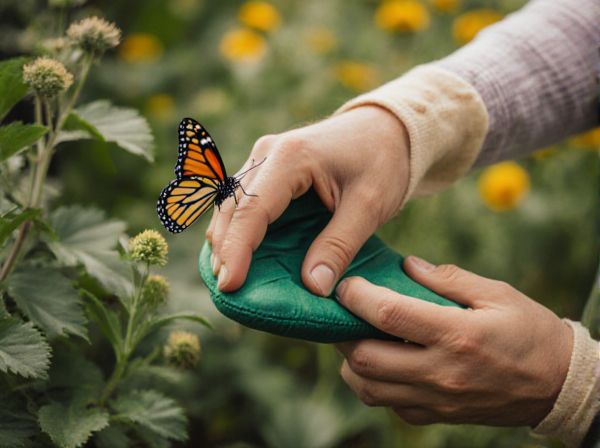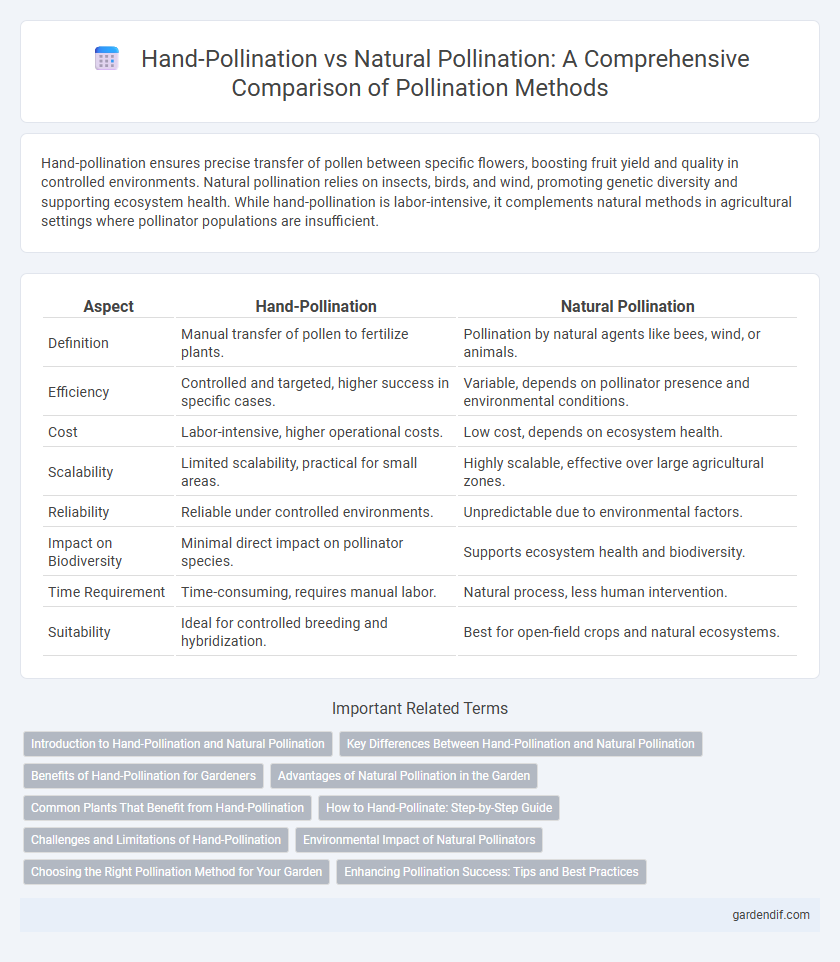
Hand-pollination vs Natural pollination Illustration
Hand-pollination ensures precise transfer of pollen between specific flowers, boosting fruit yield and quality in controlled environments. Natural pollination relies on insects, birds, and wind, promoting genetic diversity and supporting ecosystem health. While hand-pollination is labor-intensive, it complements natural methods in agricultural settings where pollinator populations are insufficient.
Table of Comparison
| Aspect | Hand-Pollination | Natural Pollination |
|---|---|---|
| Definition | Manual transfer of pollen to fertilize plants. | Pollination by natural agents like bees, wind, or animals. |
| Efficiency | Controlled and targeted, higher success in specific cases. | Variable, depends on pollinator presence and environmental conditions. |
| Cost | Labor-intensive, higher operational costs. | Low cost, depends on ecosystem health. |
| Scalability | Limited scalability, practical for small areas. | Highly scalable, effective over large agricultural zones. |
| Reliability | Reliable under controlled environments. | Unpredictable due to environmental factors. |
| Impact on Biodiversity | Minimal direct impact on pollinator species. | Supports ecosystem health and biodiversity. |
| Time Requirement | Time-consuming, requires manual labor. | Natural process, less human intervention. |
| Suitability | Ideal for controlled breeding and hybridization. | Best for open-field crops and natural ecosystems. |
Introduction to Hand-Pollination and Natural Pollination
Hand-pollination involves the manual transfer of pollen from the male anther to the female stigma, ensuring precise and controlled fertilization in plants. Natural pollination occurs through biotic agents like bees, butterflies, and birds or abiotic factors such as wind and water, facilitating genetic diversity and ecosystem balance. Understanding the distinctions between these methods highlights their roles in crop production, biodiversity, and agricultural sustainability.
Key Differences Between Hand-Pollination and Natural Pollination
Hand-pollination involves the manual transfer of pollen using tools or human intervention, ensuring precise control over plant breeding and crop production, unlike natural pollination which relies on insects, wind, or animals for pollen distribution. Natural pollination promotes biodiversity and ecosystem sustainability, whereas hand-pollination offers higher reliability in environments with declining pollinator populations or in controlled agricultural settings. Key differences include accuracy, labor intensity, pollinator dependency, and environmental impact, with hand-pollination suited for targeted crop improvement and natural pollination sustaining ecological balance.
Benefits of Hand-Pollination for Gardeners
Hand-pollination allows gardeners precise control over plant breeding and ensures pollination success when natural pollinators are scarce, boosting fruit yield and quality. This method helps target specific plant varieties, increasing genetic diversity and enabling the production of hybrid seeds with desired traits. It also mitigates risks posed by unpredictable weather conditions that can limit natural pollinator activity, ensuring consistent crop production.
Advantages of Natural Pollination in the Garden
Natural pollination enhances biodiversity by supporting native pollinators like bees, butterflies, and birds, improving plant resilience and ecosystem health. It ensures genetic diversity through cross-pollination, which strengthens crop resistance to diseases and environmental stress. Relying on natural pollinators reduces labor and costs associated with hand-pollination, making it a sustainable choice for garden productivity.
Common Plants That Benefit from Hand-Pollination
Hand-pollination significantly improves fruit set and yield in common plants such as tomatoes, cucumbers, and vanilla orchids by ensuring precise pollen transfer. Unlike natural pollination, which relies on bees, wind, or other agents, hand-pollination guarantees pollen reaches the target stigma, especially in greenhouses or areas with low pollinator activity. This technique is crucial for self-pollinating plants and those with irregular or insufficient natural pollination, enhancing crop productivity and quality.
How to Hand-Pollinate: Step-by-Step Guide
To hand-pollinate, first identify the flower's male and female parts, typically stamens and pistils. Use a small brush or cotton swab to collect pollen from the stamen and gently transfer it onto the stigma of the flower's pistil. Repeat this process daily during the flowering period to ensure successful fertilization and fruit set.
Challenges and Limitations of Hand-Pollination
Hand-pollination faces challenges such as labor intensity, limited scalability, and increased risk of human error, which can reduce pollination efficiency compared to natural pollination. It requires precise timing and skill to mimic the complex interactions of natural pollinators like bees and butterflies, often resulting in inconsistent fruit set and yield. Furthermore, hand-pollination cannot replicate the genetic diversity benefits provided by natural pollinators moving across larger areas.
Environmental Impact of Natural Pollinators
Natural pollinators, including bees, butterflies, and birds, contribute significantly to ecosystem health by maintaining biodiversity and supporting plant reproduction without chemical inputs. Their activity enhances soil quality and carbon sequestration through diverse plant growth, promoting a balanced environment. In contrast to hand-pollination, which can be labor-intensive and limited in scale, natural pollinators provide widespread and sustainable pollination services crucial for agricultural productivity and ecological stability.
Choosing the Right Pollination Method for Your Garden
Hand-pollination ensures targeted pollen transfer, improving fruit set in gardens with limited pollinator activity or isolated plants. Natural pollination leverages bees, butterflies, and other insects, promoting biodiversity and requiring less manual effort, ideal for larger or diverse garden spaces. Selecting the appropriate pollination method depends on plant species, garden size, and local pollinator populations to optimize yield and ecosystem health.
Enhancing Pollination Success: Tips and Best Practices
Hand-pollination enhances pollination success by ensuring precise pollen transfer between flowers, critical for crops with low natural pollinator activity. Using fine brushes or cotton swabs to collect and apply pollen boosts fertilization rates and improves fruit set in controlled environments. Maintaining pollen viability through proper storage and timing pollination during peak flower receptivity maximizes yield in both agricultural and horticultural settings.
Hand-pollination vs Natural pollination Infographic

 gardendif.com
gardendif.com